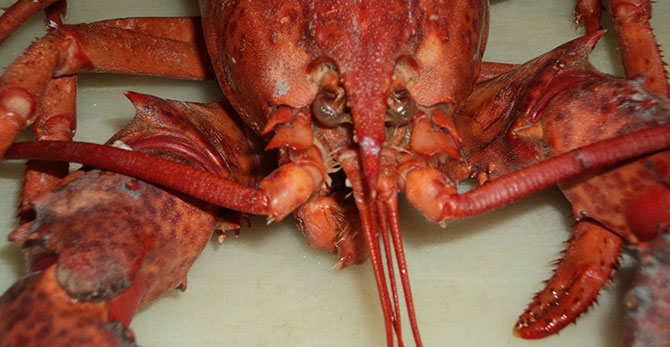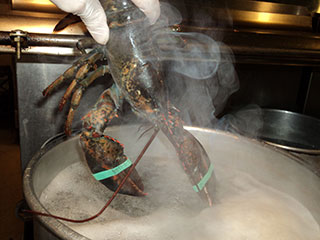A Lobster Treatise
by Joe George

Examining the guilt and the pleasure of crustacean cookery
A few nights ago I killed a lobster. A lot of lobsters, actually—10 dozen to be exact. I didn’t carry out this gruesome task alone, a few cooks helped me, but they mostly cut and cracked the lobster’s shells after I had sent them to their boiling demise.
I’m not bragging; it had to be done. It’s part of my work. It’s not that I enjoyed doing it, either, and I have to admit that I’ve become somewhat desensitized. I also have to qualify these sentiments by stating that I am not a vegetarian and am keenly aware that something often dies before it reaches my plate.
In this age of hyper-packaging, I think it’s easy to disassociate food with life, that all flesh was once part of an actual living animal and not simply a glistening piece of shrink-wrapped protein on a supermarket shelf. Cooks, I also believe, can be less removed from this than the layperson, but still it’s easy to forget…though not when you’re doing the killing.
I’d never really thought of this much until about 10 years ago. I was visiting in-laws in the Midwest and the host was grilling burgers. He lives in a rural area and there were free-range cows wandering about, who sometimes would come within arm’s length. This is exactly what happened as I was handed a bloody-rare burger. As I bit in two cows stared and mooed at me. I truly doubt if they knew I was eating beef, but nonetheless I couldn’t finish the burger. It was an epiphanic moment.


Recently I toured at a heritage hog farm. The animals were beautiful and impressive. I was impressed by how pridefully the farmer spoke of them and touched them as he talked, pointing out prized cuts of meat that were still on the animal, hidden under hair and skin. Then out came a trail of little piglets, oinking behind their enormous and somewhat scary mother. The piglets were so cute and cuddly looking; their motions and snorts reminded me very much of my two pet pugs. I’ll never eat pork again, I thought. But shortly thereafter the smell of sizzling bacon lured me back. Bacon does not resemble an animal in any way, so it’s easy to be in denial.
Before I began dropping lobsters into 20 gallon pots, I did what I do every year at the beginning of this annual lobster dinner. I gave a moment of silence, quietly asked God for forgiveness, and then apologized to the first victim as I held it in my hand. And as I held it, looking into its beady eyes, I wondered aloud why I didn’t just eat vegetables. Then I dropped it headfirst into a pot, then another, and another after that. Soon I was dropping them a half-dozen at a time. Some of them were docile as I picked them up, accepting their fate—or possibly just stunned from being in a refrigerated box. Others moved in a sloth-like manner, making a final and futile attempt at escape. And a small percentage were fiery and feisty until the very minute they hit the boiling liquid, flipping and flopping as I tried to pick them up and attempting to catch me with their claws, even though they were bound with rubber bands. These were the ones who bothered me—the ones who fought until the very end.
I’ve read that lobsters have such primitive nervous systems that they are incapable of feeling pain. But this knowledge doesn’t make the slaughter any easier, at least not for me. Apparently I’m not the only one who feels this way because the Internet abounds with people sharing this same sentiment. There’s even a company in Great Britain that produces a machine they call the Crustastun, a machine that electrocutes lobsters, which they claim is the swiftest and most compassionate way to kill a crustacean.
I’ve also read that splitting its head in half with a sharp knife is more humane. Supposedly, if done correctly the blade immediately severs the lobster’s brain, thus killing it more quickly than hot water. I have used both of these methods, and while I find the splitting method more gruesome, I do believe it more humane. But neither is easy for me. If I personally were given only those two choices for my own finish, I’m not sure which I would choose. Both are hideous.
I’m don’t know if lobsters do feel pain—I truly hope they don’t—but one thing’s for sure: They don’t scream. That’s a fallacy. After cooking hundreds—possibly thousands—throughout my career I’ve never heard one scream, or make any sound for that matter. I’ve asked other chefs and none has ever heard a lobster scream.
The guests at the banquet enjoyed their meal, and not surprisingly, the same co-workers who only hours before thought we were cruel picked and nibbled at the lobsters now that they were dead and cut up, so that they no longer looked like living crustaceans. I still enjoy eating lobster, though I couldn’t that night.
What I find interesting is the history of lobster eating in our country—how exceedingly expensive it is today, considered to be the crème de la crème of meals. This wasn’t always the case; it was the opposite. At one time lobster was considered poor people’s food and so lowly that it was used as bait with which to catch cod. According to the Gulf of Maine Research Institute, lobsters were at one time so plentiful they were used as fertilizer by Native Americans. In colonial times lobster was mostly served to prisoners and servants.
Nonetheless, lobster is a delicious food and is considered pure luxury by many, and is in fact healthy and low fat. Unfortunately for the lobster, they really do taste better when cooked live. If you’re going to do this, here are few pointers to aid both you and the lobster. If you’re boiling your lobster, make sure that the pot is at a full rolling boil, and that it has a tight-fitting lid. (This isn’t to keep the lobster from jumping out; it’s to keep heat in.) The pot should be large enough to easily accommodate the lobster. A large amount of boiling water will stay boiling and do the deed rather quickly. And when submerging the lobster, do so headfirst—I’ve read that this will kill it quicker than tail-first.
If you’re going to split the lobster with a knife while it’s still alive—and some recipes actually require this—then you may require another person present for emotional support. Place the lobster on a cutting board. If you are right-handed have the head facing to your right; if you are left-handed, to the left. Locate the markings on the top of the shell near the head that makes a sort of cross. Hold the knife vertically and place the tip of the blade (which should be heavy and sharp) at the cross, the blade facing its face. With one fell motion, force the knife down until it hits the cutting board and at the same time bring the blade down horizontally through its face. Quickly reverse the knife and cut the back half down the middle, severing it in two. (Don’t be shocked to see that it continues to move.) It’s ready to grill at this point. To further prepare it for sautéing, cut off the claws and legs and crack them with the back of the knife, and then cut the tail portions from the body.
For more information, both for and against cooking live lobsters, visit the following websites. And before you cook them please don’t forget to apologize.
• Cooking-Lobster.com: cooking-lobster.com
• Crustastun: crustastun.com
• Gulf of Maine Research Institute: gmri.org
• Lobster Liberation: lobsterlib.com
• Maine Lobster Council: lobsterfrommaine.com
• The Lobster Institute: lobster.um.maine.edu
How To Boil a Lobster
Bring a very large pot of salted water to a rolling boil. Quickly but carefully lower the lobsters headfirst into the boiling water. Simmer for about 10-12 minutes. Serve with fresh lemon and melted butter.
Corn and Lobster Chowder
Serves eight|
2 cups of cooked lobster meat, diced 3 slices bacon, diced 1 small onion, peeled and diced 1 red bell pepper, diced 2 medium potatoes, peeled and diced 3 cups corn kernels |
2 tablespoons unsalted butter 2 cups chicken broth 2 cups clam broth 1 cup heavy cream 3 tablespoons flour 1 teaspoon sweet paprika |
1 bay leaf 1/2 teaspoon kosher salt 1/2 teaspoon black pepper 2 scallions, sliced 1/4 cup flat-leaf parsley, chopped |
DIRECTIONS: Melt the butter in a soup pot and add the bacon, onion, and bell pepper. Cook this over low heat for abut five minutes. Stir in the flour and paprika; cook for another few minutes while stirring. Add the chicken broth, clam broth, bay leaf, salt, and pepper; whisk to remove any lumps. Increase the heat to a boil, then lower it to a simmer. Add the potatoes and corn; simmer for about 10 minutes. Stir in the cream and lobster, return to a simmer, and cook another 10 minutes. Stir in the scallion and parsley just before serving.
Lobster à l’Américaine
Serves two|
2 live lobsters 4 ounces butter, divided 1 clove garlic, peeled and minced 1/2 cup brandy |
1 cup white wine 3 tablespoons flour salt and pepper 2 shallots, peeled and minced |
1 cup fish stock or clam juice 2 tomatoes, seeded and diced |
DIRECTIONS: Prepare the lobster for sautéing by splitting, quartering, and cracking its claws. Heat two ounces of butter over medium-high heat in a heavy skillet. When the butter bubbles, add the lobster and sauté it for a minute or two. Add the flour, shallot, and garlic; sauté for another minute. Remove the pan from the heat and add the brandy. Return the pan to the stove and flambé; cook it until the flame burns out. Add the wine and simmer for five minutes. Stir in the fish stock and tomatoes. Cook it until it reduces by half and thickens slightly. Arrange the lobster on a warmed platter while keeping the sauce simmering. Season the sauce with a little salt and pepper, and then swirl in the remaining two ounces of butter. Pour a portion of the sauce over the lobster. Serve remaining sauce on the side.
Lobster Salad with Fresh Tarragon
Serves four|
4 live lobsters 1 shallot, peeled and minced |
3 tablespoons fresh lemon juice 1/3 cup mayonnaise | 2 tablespoons chopped fresh tarragon |
Boil the lobsters, then refrigerate until completely cooled. Remove the meat from the lobsters, saving the tomalley and shells for lobster stock (these may be frozen). Dice the meat and mix with the remaining ingredients.
blog comments powered by Disqus
|
Issue Navigation> Issue Index > v9n26 (Summer Food Issue: week of Thursday, July 1) > A Lobster Treatise This Week's Issue • Artvoice Daily • Artvoice TV • Events Calendar • Classifieds |









 Current Issue
Current Issue